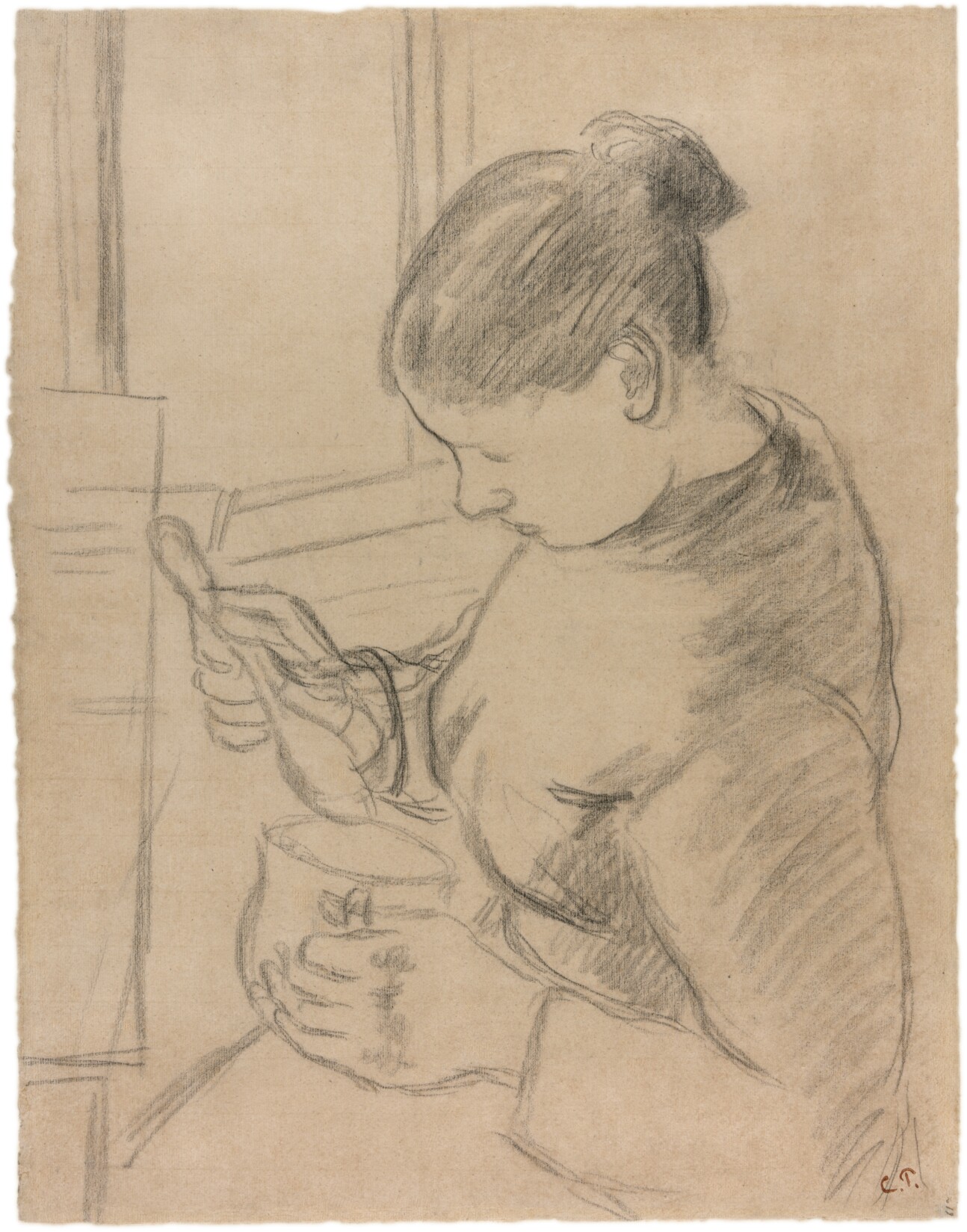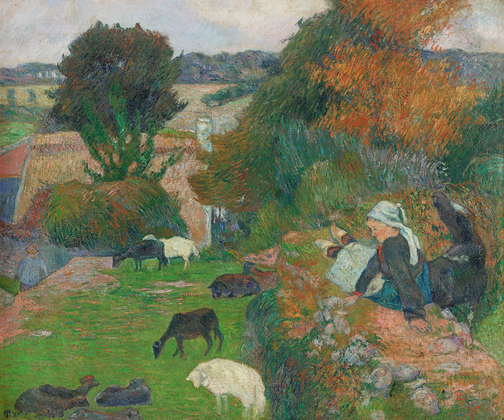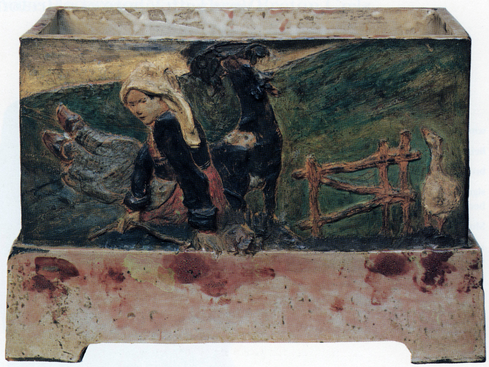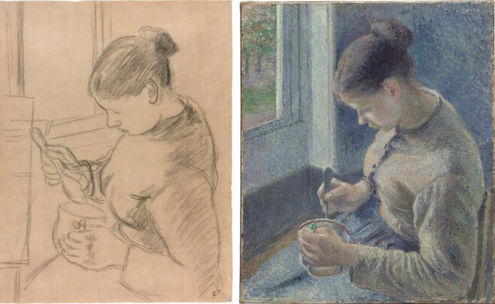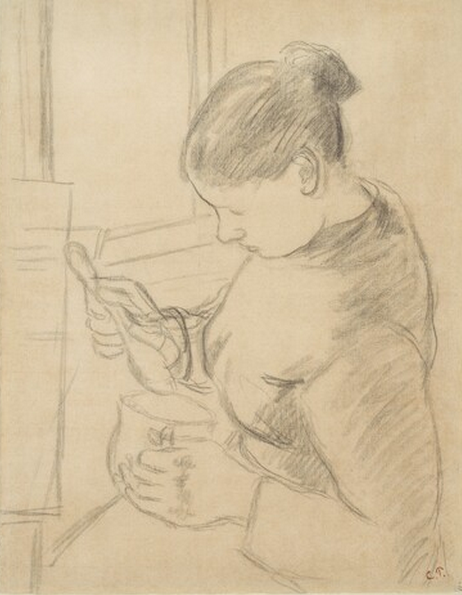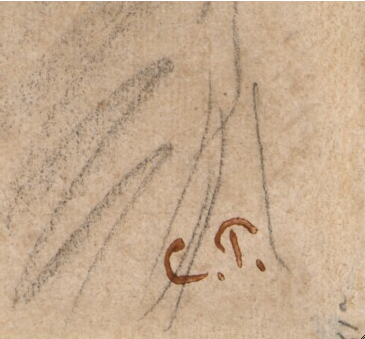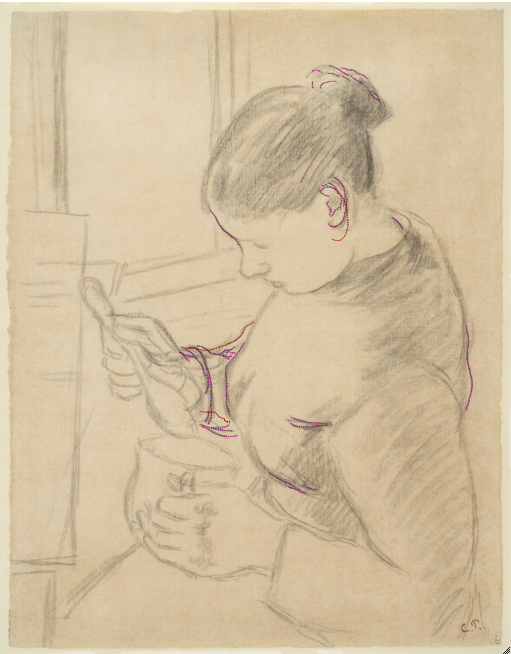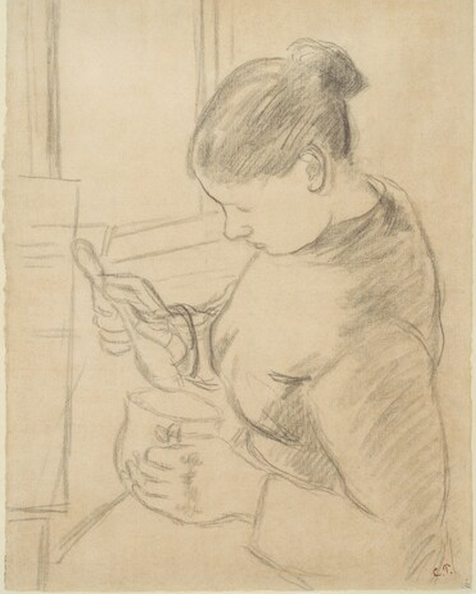Cat. 9
Young Peasant Having Her Coffee
1879/80
Black chalk on buff laid paper, laid down on cream wove paper; 614 × 479 mm
Signed: C.P. (lower right corner, in reddish-brown ink)
The Art Institute of Chicago, Regenstein Endowment Fund, 2010.540
The Art Institute of Chicago acquired this sheet in part because the museum already owned the painting for which this drawing is the principal study (cat. 10). Joachim Pissarro was the first to publish photographs of the drawing and painting together in his 1993 monograph, although his text deals with the larger issues involved in the artist’s rural figural work rather than the precise translation of drawing to painting. In fact, Pissarro’s large-scale drawings of figures in his paintings survive in sufficient numbers to make it clear that he never painted a figure without first drawing it. In several cases there seems to have been an almost one-to-one scalar relationship between the drawn and painted figures (fig. 1.4 and fig. 1.8). Yet in no case yet examined does there seem to have been any direct transfer of drawing to [glossary:underdrawing].
Instead, it seems more likely that the artist drew the figure to rehearse his representation before making another drawing freehand on the primed canvas itself. Accordingly, when he had achieved the principal contours of the figure with black chalk, he stopped his work and began to plan the placement of the figure on his canvas. The extent of the changes on the canvas suggests a long working period, perhaps months in duration, between the completion of the drawing and that of the painting, which was not uncommon in his process.
Pissarro’s approach resembles that of his friend Edgar Degas, with whom he worked on printmaking projects in the late 1870s and early 1880s, when this sheet was made. This endeavor threw the two artists together in studio settings that encouraged technical conversation and sharing of methods. Pissarro also transmitted a good deal of this complex working method, rooted in drawing, to his most important “pupil” of the period, Paul Gauguin, who probably prepared his figural paintings in similar ways (see fig. 1.1, fig. 1.2, and fig. 1.3).
This imposing sheet and others like it were kept by the artist for possible future use and as a record of his working method. It must be stressed, however, that Pissarro most likely made both the drawing and the painting from a posed model, rather than completing the drawing from the template and then using it as the model for the figure in the painting. Indeed, Pissarro may have even used different models for the drawing and the painting. Like comparable figure drawings by Degas, this and other similar sheets were marked with estate stamps at the time of his death and divided among his surviving family members. They were not intended to be seen by others, either shown publicly or sold. In fact, it was not until after World War II that interest in the Impressionists’ working methods awakened.
Richard R. Brettell
Technical Report
Technical Summary
Pissarro drew Young Peasant Having Her Coffee in black chalk on buff [glossary:laid paper]. The overall composition was worked out with a relatively hard chalk that formed broad, lightly pigmented strokes. It was drawn fairly directly, except in a few areas where additional darker chalk lines were added to adjust the sleeve cuff and angle of the wrist and upper hand of the figure’s proper right arm. Additionally, the ear was raised slightly up and to the left, and the hair bun was further defined. The artist established minimal shading and volume along the figure’s back and beneath her arm by working the chalk stick quickly back and forth.
The drawing is a preparatory study for an [glossary:oil] painting of the same subject (see cat. 10). Although closely related, the two works differ slightly in the figure’s general form and orientation as well as in the placement of her hands and the orientation of the spoon and cup that she holds (fig. 1.5). Moreover, there is no visible pricking or incising to indicate that the work was used for transfer.
Media and Support
Support Characteristics
Primary paper type
Cream (discolored to buff), medium-thick, moderately textured laid paper.
Paper fabrication
Watermark
L. Berville (top left edge, vertical orientation); Lalanne (bottom right edge, vertical orientation).
Chain line orientation and frequency
Horizontal, 28 cm.
Laid line frequency/cm
9 per cm.
Furnish
Fairly uniform, with some inclusion of red and brown fibers.
Formation
Even.
Other characteristics
A deckle edge is preserved along the left side. The remaining edges appear to be edge torn or irregularly trimmed.
Dimensions
614 × 479 mm.
Secondary support
Cream, moderately thick, smooth [glossary:wove] paper ([glossary:lining]).
Dimensions
640 × 510 mm.
Preparatory Layers
No artistic surface alterations or coatings are visible in normal conditions or under magnification. Under UV radiation, the paper re-emits little or no visible light [glossary:fluorescence], which suggests an absence or reduction of gelatin [glossary:size].
Media Characteristics
The work is drawn directly in black chalk. Overall, the figure is worked out with broad, moderately light chalk lines. Large passages of chalk create shadows, imparting form to the figure. Fine, darker black chalk lines adjust the figure’s proper right sleeve and ear, as well as strengthen lines along her forehead, back, and chest. There is no evidence of [glossary:stumping] or erasure. The window in the background is defined with straight chalk lines.
In the process of reworking the ear, Pissarro may have partially rubbed out the former chalk lines. There is also some media transfer in the shading along the back of the figure that appears more incidental than intentional.
Compositional Development
Darker black chalk lines were used to adjust or rework some areas of the figure. The sleeve cuff and angle of the wrist and upper hand of the figure’s proper right arm were adjusted to a slightly higher angle (fig. 1.7). Additionally, the ear was raised slightly up and to the left and the hair bun was further defined.
Surface Treatment
No artistic surface alterations or coatings are visible in normal conditions, under [glossary:UV] radiation, or under magnification.
Condition History
The drawing was lined overall to a moderately stiff wove paper. The primary paper [glossary:support] is slightly discolored overall. There are small losses, light surface abrasion, and discoloration along the edges; some losses were formerly filled with a toned paper. There is light transfer of media across the paper surface, particularly in the shading along the back of the figure.
Examination under UV radiation revealed numerous spots that emit a faint white visible-light fluorescence that is characteristic of some types of [glossary:foxing] spots that are fungal in origin. The spots may have formerly been more visible but were reduced through treatment. The paper slightly absorbs UV radiation, which is characteristic of a loss or absence of gelatin [glossary:sizing]. The work was lined overall on the verso with a moderately thick wove paper, and due to the stiffness of the lining paper, the drawing has a slightly concave curl, rising upward slightly at the top and bottom edges.
Kimberly Nichols
Provenance
Estate of the artist, from 1903.
Maus Collection, Geneva, Switzerland.
Wildenstein and Company, New York, by Aug. 2010.
Sold by Wildenstein and Company, New York, to the Art Institute of Chicago, 2010.
Exhibition History
Williamstown, Mass., Sterling and Francine Clark Art Institute, Pissarro’s People, June 12–Oct. 11, 2011; and Fine Arts Museums of San Francisco, Oct. 22, 2011–Jan. 22, 2012.
Selected References
Joachim Pissarro, Camille Pissarro (Abrams, 1993), pp. 156, 158; fig. 159.
Joachim Pissarro and Claire Durand-Ruel Snollaerts, with the collaboration of Alexia de Buffévent and Annie Champié, Pissarro: Catalogue critique des peintures/Critical Catalogue of Paintings, vol. 2 (Skira/Wildenstein Institute, 2005), p. 442, under no. 662 (ill.).
Richard R. Brettell, Pissarro’s People (Fine Arts Museums of San Francisco/Sterling and Francine Clark Art Institute/Prestel, 2011), p. 189, figs. 144, 306.
Other Documentation
Inscriptions and Distinguishing Marks
Recto
Stamp
Location: lower-right corner
Method: reddish-brown ink
Content: C.P. (fig. 1.6)
Inscription
Location: [glossary:graphite]
Method: lower-right corner
Content: 61a
Examination Conditions and Technical Analysis
Raking Visible Light
Paper [glossary:support] characteristics identified.
Transmitted Visible Light
Paper mold characteristics identified.
Ultraviolet-Induced Visible Fluorescence (365 nm)
Paper characteristics and condition examined.
Binocular Microscopy (80–100×)
Media identified.
